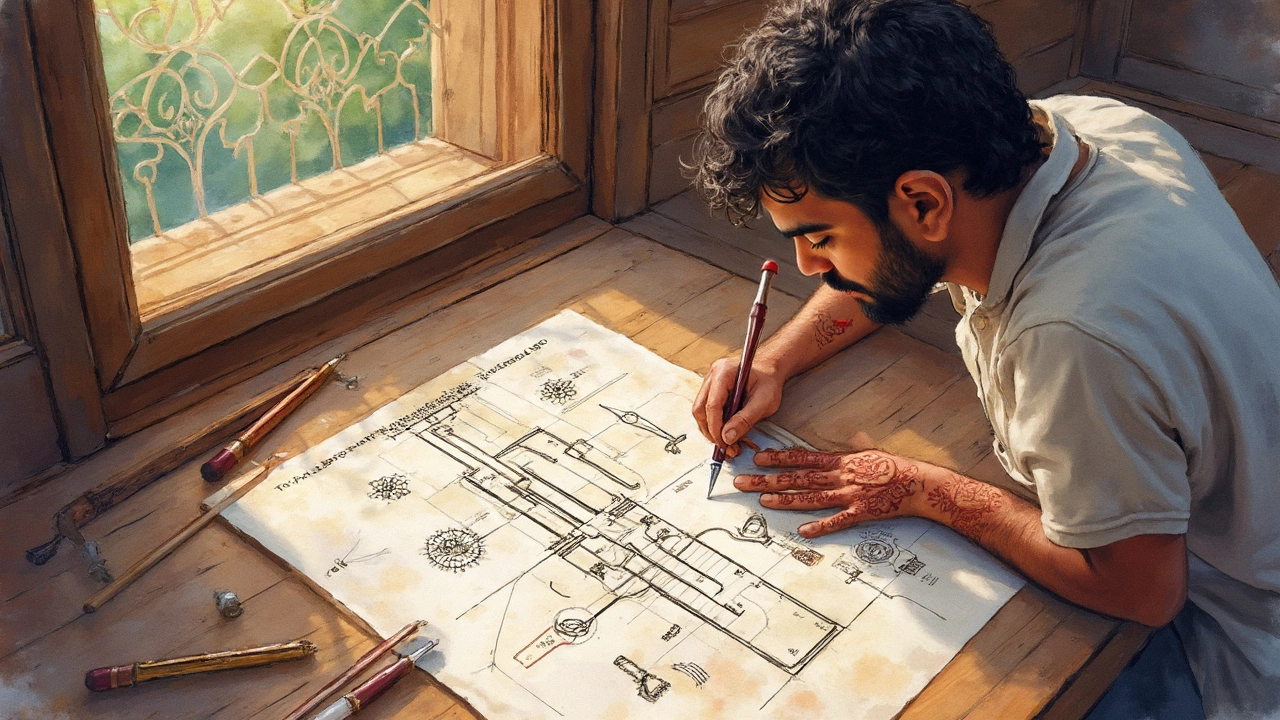So, you're thinking about becoming an electrician, huh? It's a great career choice with a lot of potential. But maybe you're a bit worried about all the talk of needing to know geometry. Is it really necessary? Let's cut to the chase — understanding some geometry can be quite helpful.
Why? Picture this: you're wiring a house and need to determine the right angles for the electrical runs. Or maybe you're aligning light fixtures just right. In cases like these, a bit of geometry knowledge can make the task easier and more efficient.
But don't freak out if math isn't your best buddy. While having a basic grasp of geometry is useful, it's not like you need to ace a math test to be a rockstar electrician. Many of the geometric concepts you'll use are pretty intuitive and come up naturally as you work. Plus, there are plenty of tools and resources out there to help you pick up what you need as you go.
- Why Geometry Matters
- Practical Applications
- Tools and Techniques
- Learning Geometry the Easy Way
- Turning Theory Into Practice
Why Geometry Matters
Alright, let's get into it. Why does geometry even matter if you're aiming to be an electrician? Well, think about the core of what electricians do: they're not just connecting wires; they're often designing and organizing complicated systems. And systems, my friend, often involve shapes and spaces — that's where geometry comes in handy.
Consider the basic requirement of determining the right placement of outlets or light fixtures to ensure everything is symmetrical and functional. That's geometry at work. You might not realize it, but aligning things in straight lines or figuring out the angles for certain installations rely on geometric principles. For example, creating pathways for electrical wiring often involves navigating around walls and structures, ensuring that your systems fit perfectly within the space.
Let's take a real-life example: wiring a house. If you're running wires through a building, you need to know the best routes — shortest paths are ideal, right? This involves understanding angles and distances, a critical aspect of geometry. You don't want to waste materials or create more work for yourself, so knowing how to measure that distance accurately saves time and resources.
Even more detailed work, like installing complex circuit boards, often requires precise placement of components, which directly relates to geometric understanding. It's this precision that keeps everything running smoothly and safely, whether you're dealing with home systems or intricate commercial setups.
To add a bit of perspective, here's a simple breakdown of where geometry fits in different tasks:
- Measuring distances: Ensuring wires and cables are the right lengths.
- Aligning elements: Making sure outlets and lights are properly positioned.
- Testing circuits: Understanding layouts to troubleshoot effectively.
So while you won't spend all day drawing triangles on paper, a basic understanding of how this fascinating field works can be a lifesaver. At its core, knowing geometry means better precision and smarter designing in the daily grind of an electrician.
Practical Applications
When it comes to understanding geometry for electricians, it’s not just about knowing the theory. It’s about applying that knowledge to solve real-world problems on the job. Let’s dig into some practical ways geometry makes a difference in this field.
One biggie is figuring out the layout and design of electrical circuits. Imagine you're planning the wiring for a new building. Knowing how to calculate angles and distances allows you to plan efficient routes, saving on materials and cutting down labor time. Avoiding unnecessary zigzags and loops is where geometry smarts come in handy.
Then there’s the task of installing light fixtures. You’ll want those placements to be just right, not only for aesthetics but for functionality. Here, geometry helps ensure all fixtures are evenly spaced and aligned correctly in a room.
Ever heard of bending conduit? It's a pretty common task where you use bending machines to shape metal pipes that electrical wires run through. Understanding angles means getting those bends precisely right so that everything fits perfectly, making it not only safe but also polished looking. It's super practical!
Let’s not forget troubleshooting. When things don’t work as expected, figuring out angles, loads, and currents using some basic geometric calculations can be key to finding a solution quickly.
Here’s a simple way you might measure angles in your daily work:
- Use a protractor or an angle finder tool. These are essential in your toolkit when precision is necessary.
- Record the angle measurements as you plan out your wiring paths and conduit bends.
- Double-check calculations to prevent errors and retake any measurements if something seems off.
So yeah, while you won’t need to become a math wizard, a beefed-up understanding of basic geometry can be a real game-changer in the electrical trade. It not only boosts your efficiency but also ups the quality of your work.

Tools and Techniques
Think geometry is all about textbooks and protractors? Think again. In the world of electrician training, there are practical tools and techniques that make understanding geometry straightforward and, dare I say, kind of fun. Let's check out some essentials you'll want to have in your toolbox.
First up, the measuring tape. It's like the Swiss Army knife of geometry in the electrical world. You’ll use it daily to measure distances and plan out how far your cables need to run or where fittings should be mounted. Keeping measurements accurate ensures everything fits perfectly, avoiding any last-minute surprises.
Then there's the level. Installing outlets or switches? Make sure they're aligned with a trusty level to avoid that annoying slant that messes with the visual flow. This tool helps maintain the right angles without overthinking it. Just hold it steady, observe the bubble, and adjust accordingly.
Ever heard of a digital protractor? For those times when getting the angle just right matters—like designing custom lighting layouts—this little gadget will save you tons of headaches. No guessing; it gives precise angle readings instantly.
When it comes to software, electrical design tools often include CAD programs that enable you to lay out entire systems, including circuits and wiring diagrams. These are a game-changer for big projects where precise planning is key. They use geometry principles behind the scenes to ensure everything works in harmony.
Finally, some seasoned electricians swear by their field manuals—guides that often include shortcuts and tips on applying basic geometry principles in everyday tasks. Let’s be real, there's nothing like a bit of wisdom from those who’ve walked the wire before you.
So, while you might start with the basics, your toolkit and finesse will grow with your experience, transforming geometry from a classroom concept into an everyday ally in your electrician's career.
Learning Geometry the Easy Way
Alright, so you're on board with the idea that some geometry can help as an electrician. How do you get started without feeling like you've enrolled in math class all over again?
First off, learning geometry doesn't have to be a bore. You can pick it up by doing—like watching YouTube videos that teach you how to calculate angles or use a protractor. Trust me, when it's applied to real-life situations like estimating wiring lengths or aligning panels, it starts to make sense real fast.
Grab a few apps on your phone that are designed to help with geometric calculations. These are super handy for quick conversions and measurements on the go. Some even use augmented reality to measure angles right through your camera! That's not just cool—it's super practical.
If you're more old school and dig books, find some geared towards construction or trades. They're more practical and less technical than your average high school textbook, focusing on the real stuff you'll use in everyday electrician training.
And don't shy away from asking for help. Whether it's from more seasoned electricians on the job or online forums, the electrician community is usually really good about sharing tips and shortcuts.
Take it one project at a time. Tackle different geometric problems as they come up in your work, and soon enough, you'll find yourself eyeballing angles like a pro. And hey, if you make a mistake, that's okay. It's all part of learning.

Turning Theory Into Practice
Alright, so you've got the theory down. But how do you actually bring that to the real world when you're working as an electrician? Let's break it down into practical steps so you can see how to apply those geometric concepts on the job.
First, imagine you're faced with designing a circuit layout in a new home. You'll need to figure out the optimal path for wiring that minimizes waste and maximizes efficiency. Here, a basic understanding of angles and how to measure them can be your best friend. It helps in planning paths that reduce unnecessary turns, saving on both materials and time.
When it comes to installing fixtures — like ceiling fans or light fittings — getting the alignment spot-on is crucial. Using geometry, you can ensure these installations are symmetrical and evenly spaced, improving both functionality and aesthetics. You might use a protractor to measure precise angles or consult blueprints where geometric shapes outline the layout.
Let's not forget the daily tools of the trade. A multimeter, for instance, measures voltage, current, and resistance; all of which require an understanding of mathematical principles rooted in geometry. Even the use of simple tools like tape measures often involves calculating transformations in angles and shapes, especially when working in uniquely structured spaces.
Now, you've heard the theory, but how do you make it stick? Practice makes perfect, and there's no substitute for hands-on experience. Many electrician training programs offer workshops simulating real-world scenarios where you can apply your geometric skills. And the more you practice, the more intuitive it becomes.
Finally, let's talk resources. Don't hesitate to pick up some learning aids or apps on geometry if you're feeling rusty. There are numerous books and online courses focused specifically on how geometry applies to trade work. Take advantage of those to keep sharp and improve your efficiency on the job!
